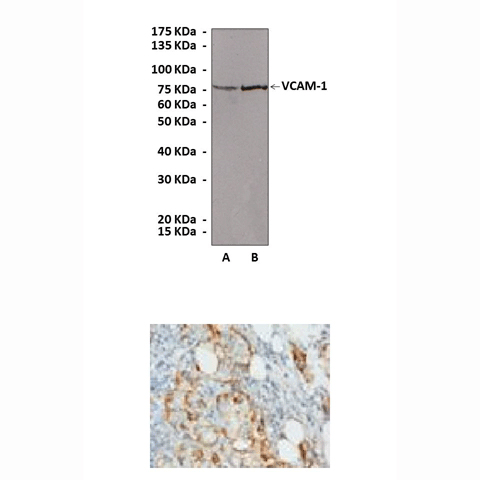Product Sheet CA0406
Description
BACKGROUND VCAM-1 (vascular cell adhesion molecule-1), or CD106, is an immunoglobulin-like adhesion molecule. It contains six or seven immunoglobulin domains and is expressed on both large and small vessels only after the endothelial cells are stimulated by cytokines.1 Moreover, VCAM-1 expression is induced on endothelial cells during inflammatory bowel disease, atherosclerosis, allograft rejection, infection, and asthmatic responses. Primarily, VCAM-1 is an endothelial ligand for VLA-4 (Very Late Antigen-1 or alpha4beta1) of the beta1 subfamily of integrins and for integrin alpha4beta7. VLA-4 is expressed on most leukocytes and plays an important role in leukocyte trafficking by interacting with VCAM-1 on endothelial cells to mediate tethering, rolling, firm adhesion and transendothelial migration. During these responses, VCAM-1 forms a scaffold for leukocyte migration. VCAM-1 also activates signals within endothelial cells resulting in the opening of an “endothelial cell gate” through which leukocytes migrate. Immediately following this migration, the endothelial cell–endothelial cell contact is re-established. VCAM-1 outside-in signals are mediated by NADPH oxidase production of reactive oxygen species and subsequently activation of matrix metalloproteinases. These signals are required for endothelial cell shape changes and leukocyte migration.2 In addition, VCAM-1/VLA-4 interaction has also been implicated in the compartmentalisation of B cells into peripheral lymphoid tissue, the association of neutrophils with bone marrow (BM) stromal cells, the promotion of interactions between follicular dendritic cells (FDC) and B cells, and in the formation of a docking structure that surrounds the B cell receptor (BCR) and TCR in the immunological synapse (IS) that forms between antigen presenting cells and antigen-specific B and T cells.2 Interestingly, certain melanoma cells can use VCAM-1 to adhere to the endothelium, and VCAM-1 may participate in monocyte recruitment to atherosclerotic sites. As a result, VCAM-1 is a potential target drug target.3
REFERENCES
1. Chen, T.C.: et al.: J Neuroimmunol.:73 (1-2): 155-61, 1997.
2. Carter, R.A., I.P., Wicks: Arthritis Rheum.: 44(5): 985-94, 2001.
2. Carter, R.A., I.P., Wicks: Arthritis Rheum.: 44(5): 985-94, 2001.
Products are for research use only. They are not intended for human, animal, or diagnostic applications.
Details
Cat.No.: | CA0406 |
Antigen: | N- terminal sequence of human VCAM-1 |
Isotype: | Affinity-Purified Rabbit Polyclonal IgG |
Species & predicted species cross- reactivity ( ): | Human, Rabbit, Rat, Mouse |
Applications & Suggested starting dilutions:* | WB 1:500 - 1:1000 IP n/d IHC (Paraffin) 1:50 - 1:200 ICC n/d FACS n/d |
Predicted Molecular Weight of protein: | 82 kDa |
Specificity/Sensitivity: | Anti-CD106 reacts specifically with CD106 of human, rabbit, mouse & rat origin in Immunohistochemistry (membrane/cytoplasmic staining) and western blotting (110 kDa band), non-cross-reactive with other adhesion molecules. |
Storage: | Store at 4° C for frequent use; at -20° C for at least one year. |
*Optimal working dilutions must be determined by end user.

